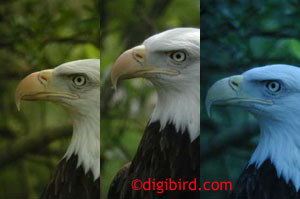|
Color balance: This is one of the trickiest areas
of digital photography, and the best general advice I can
give is to simply set the control to automatic; if necessary,
you can fix this later in post-processing. Most of the
time, especially if the subject is well-illuminated, this
will get pretty close. My impression is that the Nikon is a
bit weak in the blue channel, resulting in a slightly yellow
cast in the raw image. Almost any image editing software
(even those available free) will let you tweak this.
Sensitivity: The sensitivity of the CCD imager is
set with the "ISO" control. This control is analogous to
the film ISO (formerly ASA) rating, and involves an
analogous tradeoff: as sensitivity increases, so does noise.
Noise--a random distribution of light and dark pixel levels
superimposed on your image--reduces the clarity of the final
image, especially if overall light levels are low. Try to
shoot at ISO 100. Only if you are desperate to obtain an
image should you shoot at ISO 400.
Sharpening, contrast ('image adjustment'), 'best shot
selector': You'd like the camera to minimize any
adjustments of the recorded image; you'd rather take full
control of this process with editing software. So set
"sharpening" to off, "image adjustment" to "normal", and
best shot selector to "off".
|

Click for color balance tests
|
|

Digibird link: wild eagles
Camera CCD noise at ISO=200 and 400
|

Click for ISO, metering, camera zoom tests
|










